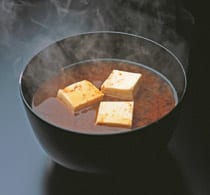Types of soy foods
Edamame are raw green soybeans, harvested when the beans are still young and sweet. As a whole food, they’re high in fiber and the protein is naturally intact. Edamame are sold fresh in the pod and frozen, shelled or unshelled.
Soybeans are hard, dry beans that have ripened in the pod. Soak in plenty of water overnight in the refrigerator, then cook for three to four hours to use in stews and soups. Cook thoroughly or they’ll be hard to digest.
Soynuts are whole soybeans that have been soaked in water, lightly oiled and baked until brown. They’re a convenient, crunchy snack food and maintain intact the high protein and isoflavones valued in soy foods.
Soynut butter is made from roasted whole soynuts that are ground and sometimes blended with soybean oil. Soynut butter contains significantly less fat than peanut butter.
Miso is a rich, salty paste made from a fermented mixture of soybeans and a grain, such as barley or rice. Use it as a base for broth, soup or condiments such as dips, dressings or sauces.
Convenience soy foods are designed as alternatives for many meat, chicken or dairy products. They include soy dogs, soy burgers, soy jerky and soy cheeses. While high in protein, they’re based on isolated soy protein (soy protein isolate).
Soy flours are gluten-free and may substitute in small amounts for other flours in recipes to tenderize baked goods. Sensitive to light and heat, soy flour should not be used to dredge foods for sautéing. Refrigerate or freeze in tight glass containers.
Soy milk, also labeled as soy beverage, is made by cooking the creamy milk of crushed soybeans. Most brands add sweeteners, nutrients or plant based thickening agents, such as carrageen, to give soy milk a consistency similar to cow’s milk.
Soy yogurt, cream cheese, sour cream and frozen desserts are all based on soy milk as the basic ingredient.
Soy cheese is made from soy milk and sometimes isolated soy proteins. Unless specifically labeled as non-dairy or vegan, soy cheese typically contains cow’s milk protein called casein or caseinate.
Soy infant formula, made from a soy protein isolate base, is for infants not able to nurse or tolerate dairy-based formulas. Some nutritionists and physicians question the effect of infants consuming concentrated isoflavones — the estrogen-like compounds in soy — over extended periods of time.
Soybean oil has a neutral flavor, contains no cholesterol and is a simple way to add healthy omega-3 and omega-6 essential fatty acids into the diet.
Soy sauce (tamari, shoyu) traditionally is the salty liquid by-product from making miso and is used for seasoning. Choose a “naturally brewed” product instead of chemically extracted, mass-market sauces flavored with corn syrup. Shoyu is made from a blend of soybeans and wheat. Tamari is a wheat-free variety.
Tempeh is a fermented food made of whole soybeans or a mixture of soybeans, grains and seeds. It’s high in protein and fiber and is a good source of iron and zinc. Tempeh can be fried, baked or barbecued, but should be cooked at least 10 to 15 minutes for digestibility.
Textured soy protein (TSP) is a highly processed source of soy protein that appears in many packaged foods. In bulk form, it readily absorbs liquid and takes on the flavor of other ingredients in a recipe.
Textured vegetable protein (TVP®) is similar to textured soy protein. TVP is higher in protein and iron than TSP and rich in potassium, magnesium and phosphorus.
Tofu is a soybean curd created by stirring a thickener into warm soy milk. It comes in soft, firm or extra-firm varieties. Non-silken varieties can be an excellent source of calcium if the thickening agent contains calcium.

